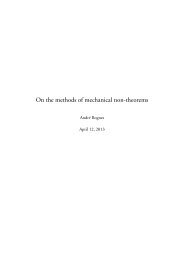The passive voice in written and spoken Scandinavian
The passive voice in written and spoken Scandinavian
The passive voice in written and spoken Scandinavian
Create successful ePaper yourself
Turn your PDF publications into a flip-book with our unique Google optimized e-Paper software.
Table 1. Inflection of the morphological <strong>passive</strong> <strong>in</strong> Danish, Norwegian <strong>and</strong> Swedish<br />
In Swedish the tense paradigm is complete, <strong>and</strong> there are no structural restrictions<br />
mentioned <strong>in</strong> the grammatical literature. In this respect Danish <strong>and</strong> Norwegian<br />
st<strong>and</strong> out from Swedish. In Danish <strong>and</strong> Norwegian the tense paradigm <strong>in</strong> the<br />
morphological <strong>passive</strong> has considerable gaps <strong>in</strong> the past tenses. <strong>The</strong> compound past<br />
tense forms are ungrammatical, whereas the preterite tense can only be used with<br />
some regular verb classes (those end<strong>in</strong>g with –e <strong>in</strong> the preterite tense; i.e. the first<br />
<strong>and</strong> second conjugation <strong>in</strong> Danish (kastede-s, brugte-s) <strong>and</strong> the second conjugation<br />
<strong>in</strong> Norwegian (brukte-s)). Irregular verbs can generally not be used <strong>in</strong> the preterite<br />
tense with the morphological <strong>passive</strong> (*sang-s). <strong>The</strong> miss<strong>in</strong>g past tense forms <strong>in</strong><br />
Danish <strong>and</strong> Norwegian have traditionally been expla<strong>in</strong>ed as a consequence of<br />
morphological <strong>and</strong> phonological factors (Diderichsen 1962: 119, Hansen 1967: 47;<br />
Western 1921: 160, Faarlund et al. 1997: 513).<br />
Periphrastic <strong>passive</strong> constructions are, as mentioned above, formed by an<br />
auxiliary verb <strong>and</strong> a ma<strong>in</strong> verb. Table 2 shows the tense paradigm of the periphrastic<br />
<strong>passive</strong> for the three languages. It is the auxiliary verb blive/bli that is <strong>in</strong>flected <strong>in</strong> the<br />
tense, whereas the ma<strong>in</strong> verb rema<strong>in</strong>s <strong>in</strong> perfect participle. In contrast to the<br />
morphological <strong>passive</strong>, the tense paradigm of the periphrastic constructions is<br />
complete <strong>in</strong> all three languages.<br />
Tense Danish Norwegian Swedish<br />
Inf<strong>in</strong>itive blive brugt bli brukt bli använd<br />
Present bliver brugt blir brukt blir använd<br />
Preterite blev brugt ble brukte blev använd<br />
Perfect er blevet brugt har/er blitt brukt har blivit använd<br />
Pluperfect var blevet brugt hadde/var blitt brukt hade blivit använd<br />
Table 2. Inflection of the periphrastic <strong>passive</strong> <strong>in</strong> Danish, Norwegian <strong>and</strong> Swedish<br />
If we recall the example sentences from (2c), reproduced below, we see that <strong>in</strong><br />
Swedish the perfect participle (använda) agrees with the subject (m<strong>in</strong>a bilder) <strong>in</strong><br />
number.<br />
6

















